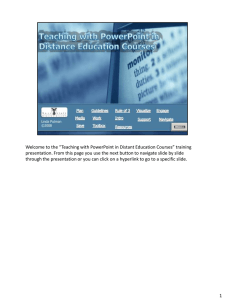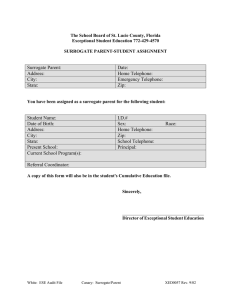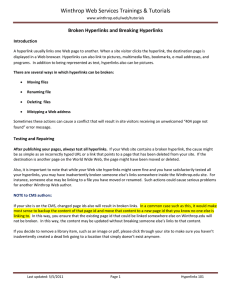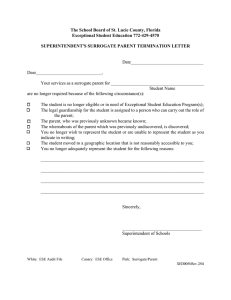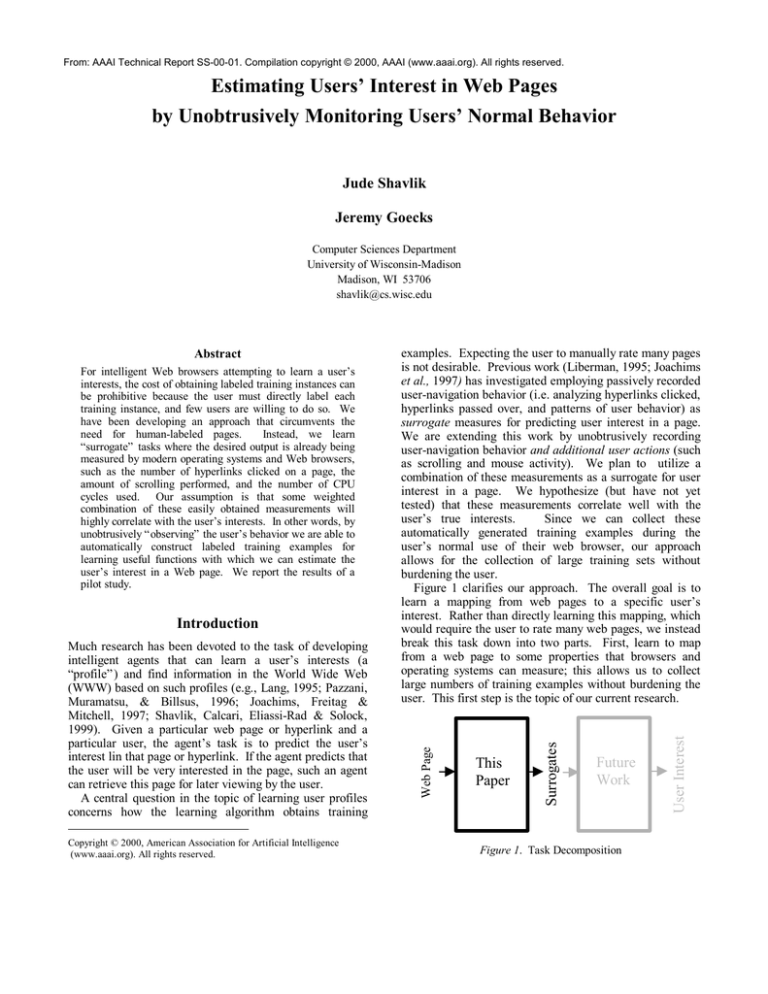
From: AAAI Technical Report SS-00-01. Compilation copyright © 2000, AAAI (www.aaai.org). All rights reserved.
Estimating Users’Interest in Web Pages
by Unobtrusively Monitoring Users’Normal Behavior
Jude Shavlik
Jeremy Goecks
Computer Sciences Department
University of Wisconsin-Madison
Madison, WI 53706
shavlik@cs.wisc.edu
Copyright © 2000, American Association for Artificial Intelligence
(www.aaai.org). All rights reserved.
This
Paper
Future
Work
Figure 1. Task Decomposition
User Interest
Much research has been devoted to the task of developing
intelligent agents that can learn a user’s interests (a
“profile”) and find information in the World Wide Web
(WWW) based on such profiles (e.g., Lang, 1995; Pazzani,
Muramatsu, & Billsus, 1996; Joachims, Freitag &
Mitchell, 1997; Shavlik, Calcari, Eliassi-Rad & Solock,
1999). Given a particular web page or hyperlink and a
particular user, the agent’s task is to predict the user’s
interest lin that page or hyperlink. If the agent predicts that
the user will be very interested in the page, such an agent
can retrieve this page for later viewing by the user.
A central question in the topic of learning user profiles
concerns how the learning algorithm obtains training
Surrogates
Introduction
examples. Expecting the user to manually rate many pages
is not desirable. Previous work (Liberman, 1995; Joachims
et al., 1997) has investigated employing passively recorded
user-navigation behavior (i.e. analyzing hyperlinks clicked,
hyperlinks passed over, and patterns of user behavior) as
surrogate measures for predicting user interest in a page.
We are extending this work by unobtrusively recording
user-navigation behavior and additional user actions (such
as scrolling and mouse activity). We plan to utilize a
combination of these measurements as a surrogate for user
interest in a page. We hypothesize (but have not yet
tested) that these measurements correlate well with the
user’s true interests.
Since we can collect these
automatically generated training examples during the
user’s normal use of their web browser, our approach
allows for the collection of large training sets without
burdening the user.
Figure 1 clarifies our approach. The overall goal is to
learn a mapping from web pages to a specific user’s
interest. Rather than directly learning this mapping, which
would require the user to rate many web pages, we instead
break this task down into two parts. First, learn to map
from a web page to some properties that browsers and
operating systems can measure; this allows us to collect
large numbers of training examples without burdening the
user. This first step is the topic of our current research.
Web Page
Abstract
For intelligent Web browsers attempting to learn a user’s
interests, the cost of obtaining labeled training instances can
be prohibitive because the user must directly label each
training instance, and few users are willing to do so. We
have been developing an approach that circumvents the
need for human-labeled pages.
Instead, we learn
“surrogate” tasks where the desired output is already being
measured by modern operating systems and Web browsers,
such as the number of hyperlinks clicked on a page, the
amount of scrolling performed, and the number of CPU
cycles used. Our assumption is that some weighted
combination of these easily obtained measurements will
highly correlate with the user’s interests. In other words, by
unobtrusively “observing” the user’s behavior we are able to
automatically construct labeled training examples for
learning useful functions with which we can estimate the
user’s interest in a Web page. We report the results of a
pilot study.
Second, learn a mapping from these surrogate
measurements to the user’s interests. We hypothesize that
this mapping can be learned from some (human) test
subjects, and the results directly applied to additional users.
In other words, new users would never need to rate web
pages. Instead, a “user-independent” model of the second
mapping would be learned “once and for all.” This second
step is a topic for our future research.
We have demonstrated (Goecks & Shavlik, 2000) that it
is feasible to learn some promising surrogate
measurements. We review those results in this article.
System Overview
Our current system involves two phases: data collection
and machine learning. Our goal is predict our surrogates
for user interest solely from the HTML contents of a web
page. Such ability could be used to, say, have a computer
program wander the web at night, collecting pages likely to
be of interest to the user when he or she wakes up.
Step 1. When the user visits a web page, record (a) the
HTML contents of the page; and (b) normal actions
performed by the user on the page.
Various user actions that appear likely to correlate with
the user’s interest in a page include the number of
hyperlinks clicked on by the user, the amount of scrolling
the user performed, and the amount the user moved the
mouse over the currently displayed web page. Thus, when
the user navigates to a new page, the agents records (a) the
text of the HTML text; (b) the number of hyperlinks the
user clicked on; (c) the amount of user scrolling activity;
and (d) the amount of user mouse activity. Of these, (a)
creates the input and (b)-(d) constitute the outputs of our
training examples.
When the user returns to a page he or she has previously
visited recently, it is logical that the agent should add the
user actions recorded during this return visit to the user
actions recorded during the previous visit. This makes
sense because often a user navigates back-and-forth to
many pages from a single “start” page, and the user is
likely very interested in this start page. Creating a new
training example for the page each time and recording only
the user actions for that particular visit does not capture the
user’s true interest in the page in this situation. Hence, a
novel aspect of our approach is that our agent sums the
actions of the user on each page visited over a finite period
of time. The active time for an instance is this finite period
of time during which the user’s actions on a page are
summed together (active time is currently set to 20
minutes). By employing the concept of an instance active
time, the agent attempts to capture the user’s true interest
in a page, whether the user performs many actions on a
page in one visit or the user revisits a page many times and
performs just a few actions on the page during each visit.
Step 2. Apply a machine learning algorithm to the
labeled training examples collected in Step 1.
Recall that our agent’s primary goal is, given the HTML
text of a web page, to predict the amount of normal user
actions on the page (i.e., our surrogates for user interest).
In other words, using the learning algorithm, the agent is to
learn to successfully predict the number of hyperlinks the
user will click on, the amount of scrolling and mouse
activity the user will perform.
Our agent currently employs a fully connected, threelayer neural network as its learning algorithm. Our choice
to initially use a neural network was made largely out of
convenience. We are currently evaluating other learning
algorithms for this task.
We base our representation of the web page on the bagof-words representation (Salton, 1991); this representation
is compatible with neural networks and empirically has
proven quite successful in information retrieval (Salton,
1991; Lang, 1995; Pazzani et al., 1996). Actually, our
agent uses an enhanced version of the basic bag-of-words
representation. We equip our agent with the ability to
handle “key phrases,” which are simply phrases the agent
is to look for as opposed to single words.
Finally, we address the issue of acquiring keywords for a
particular user. Numerous means come to mind, such as
analyzing the user’s homepage or examining the text of
web pages visited by the user and using a heuristic function
(e.g., information gain; Mladenic, 1996) to choose the
keywords from those pages’ text. The focus of this
research is independent of the means used to choose
keywords, and thus for simplicity in our initial experiments
the agent is simply provided with a list of keywords. A
“production-quality” agent would require a more
sophisticated method of choosing keywords.
Each of the network output units corresponds to a
particular user action; thus, there are three output units for
the network. The output unit for hyperlinks clicked
represents the fraction of the page’s hyperlinks that are
clicked. E.g., a value of 0.1 means that the user clicked
10% of the current page’s hyperlinks. The outputs units
for scrolling activity and mouse activity represent counts of
the events reported by Microsoft’s IE 4.0 browser, scaled
by 100. We train our network using the standard
backpropagation algorithm.
Experimental Methodology
To determine how accurately our agent can predict these
normal user actions, we performed a 10-fold crossvalidation experiment. For each fold we use “early
stopping” when training; 10% of each fold’s training data
is used as a tuning set. After training is complete, the
agent restores the network that performed best on the
tuning set. We then record the agent’s accuracy on the
fold’s test set. We use the root-mean-square method to
measure the accuracy of the network’s predictions.
The keywords for this pilot study were related to
machine learning; we used 107 key words and phrases. To
collect the data, one of us (JG) browsed the WWW while
our agent observed and collected data. The browsing
attempted to simulate a normal individual interested in
reading about various topics and research projects in
machine learning; however, browsing was not performed
with any particular questions or issues in mind. A total of
200 pages were visited over a couple of days; 150 of these
pages were related to machine learning, and the remaining
50 were not. On each page about one fifth of the hyperlinks
were clicked, there were about 40 scrolling-related events,
and there were about 70 mouse-related events.
An effort was made to visit a broad range of pages and
perform a number of different navigation actions, including
the use of the forward/back buttons, clicking on “dead”
links and links to download files, and browsing FAQ’s and
ftp sites. Although only one experimental subject was
used, we believe that the data collected for this experiment
is representative of a “real-world” data sample that might
be obtained from an ordinary user.
Table 1 summarizes these results (recall that the average
values for these three measurements were about 0.20, 0.40,
and 0.70, respectively). The data shows that the three
surrogates can be reasonably accurately predicted.
Table 1. Results of our cross-validation. The agent collected a
total of two hundred (200) instances and used ten (10) train/test
folds. For each fold, the agent set aside 10% of the data as a
tuning set for “early stopping” of the network’s training.; the
agent trains on the train’(train instances minus tune instances) set
for 100 epochs, chooses the network state that performs best on
the tune set, then measures accuracy on the test instances.
Action Predicted
Conclusions
We briefly presented and evaluated the design of an agent
that employs a standard neural network to learn a user’s
interests in the WWW. The key aspect of our system is
that it unobtrusively measures normal actions performed
by the user on a web page. It uses these measurements as a
surrogate for the desirable, but too burdensome to collect,
measurements of the user’s interest level. Hence, rather
than explicitly labeling the interest level of WWW pages,
users implicitly label web pages by the actions they
perform on them.
Our cross-validation experiment
suggests that the agent can learn to predict, to a reasonable
accuracy, the surrogate measurements of user interest that
we investigated.
Acknowledgements
This research is partially supported by NSF Grant IRI9502990 and a Vilas Associates award (to JS) from the
University of Wisconsin.
undergraduate thesis.
This work is part of JG’s
References
J. Goecks and J. Shavlik (2000). Learning Users’ Interests
by Unobtrusively Observing Their Normal Behavior, Proc.
Conf. on Intelligent User Interfaces, New Orleans.
RMS Error on Test Sets
Hyperlinks Clicked
Scrolling Activity
Mouse Activity
0.07 ± 0.02
0.05 ± 0.02
0.13 ± 0.03
T. Joachims, D. Freitag, and T. Mitchell (1997).
WebWatcher: A Tour Guide for the World Wide Web,
Proc. IJCAI-97, pp. 770-775.
K. Lang (1995). NewsWeeder: Learning to Filter News,
Proc. ICML-95, pp. 331-339.
H. Liberman (1995). Letizia: An Agent that Assists Web
Browsing. Proc. IJCAI-95, pp. 924-929.
Future Work
A number of questions have arisen from our initial work on
this agent. Our agent would greatly benefit from
improved methods for detecting user actions. The three
user actions currently detected by our agent provide a good
“first-order” approximation to the user’s activity on a web
page, but one can imagine additional properties to
automatically measure, such as CPU time expended on a
page by the browser or amount of typing the user does
within a web page.
We also plan to perform experiments using human
subjects in order to investigate the machine learning of the
right-hand box in Figure 1 (i.e., the mapping from our
surrogate measurements to users’true interests).
D.
Mladenic
(1996).
Personal
WebWatcher:
Implementation and Design, Technical Report IJS-DP7472, Department for Intelligent Systems, J.Stefan
Institute.
M. Pazzani, J. Muramatsu, and D. Billsus (1996). Syskill
& Webert: Identifying Interesting Web Sites, Proc. AAAI96, pp. 54-61.
G. Salton (1991). Developments in Automatic Text
Retrieval, Science 253:974-97.
J. Shavlik, S. Calcari, T. Eliassi-Rad, & J. Solock (1999).
An Instructable, Adaptive Interface for Discovering and
Monitoring Information on the World-Wide Web. Proc.
Conf. Intelligent User Interfaces, Redondo Beach, CA.

